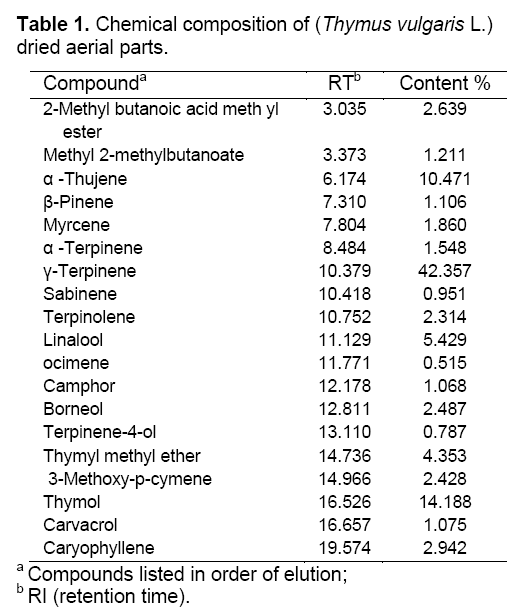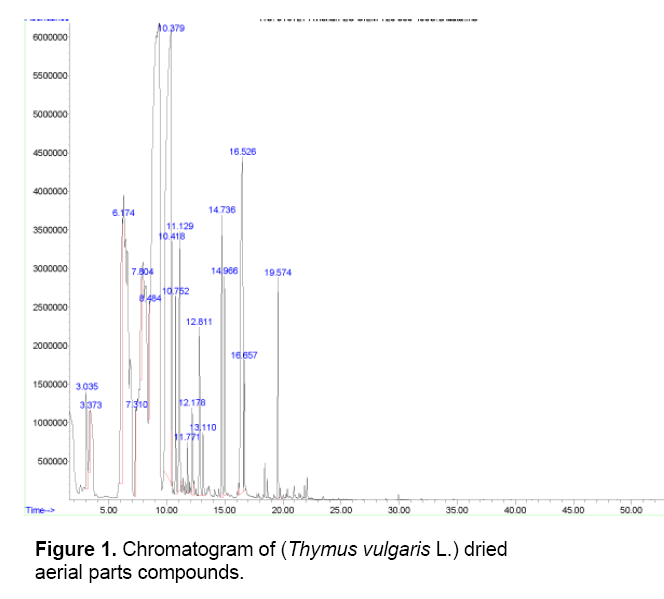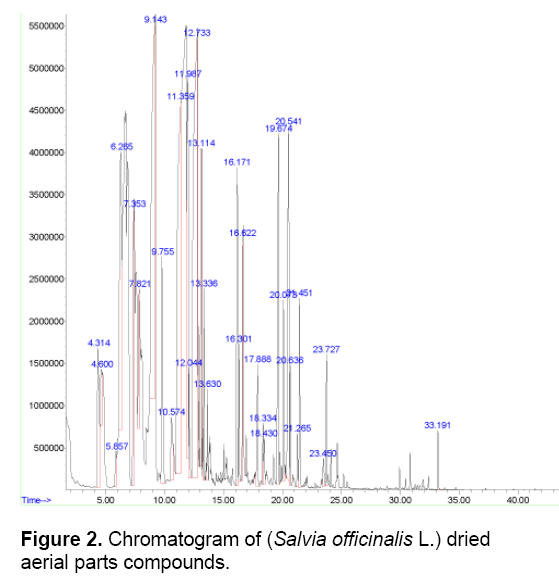Identification of the Components of Sage (Salvia officinalisL.) and Thyme (Thymus vulgarisL.) Cultivated in Isfahan Climatic Conditions
Ahmad Reza Golparvar, Amin Hadipanah
1Department of Agronomy and plant Breeding,Khorasgan (Isfahan) Branch,Islamic Azad University,Isfahan,Iran
2MSc Graduate,Horticultural - medicinal plants Science,Jiroft Branch,Islamic Azad University,Jiroft,Iran
- Corresponding Author:
- Ahmad Reza Golparvar
Department of Agronomy and plant Breeding
Khorasgan (Isfahan) Branch
Islamic Azad University,Isfahan,Iran
Tel: +983115354001
Fax: +983115354060
E-mail: dragolparvar@gmail.com
Abstract
Sage (Salvia officinalis L.) and thyme (Thymus vulgaris L.) are perennial shrub and aromatic plants belongs to Lamiaceae family, native to Mediterranean Basin. Thyme and sage contain are mixture of monoterpenes. The aim of this study was to identification of the components of Sage and thyme cultivated in Isfahan climatic conditions. The aerial parts of plants were collected in Isfahan (Mymeh) Province in 2011. The aerial parts of plants analyzed by using GC/MS in Islamic Azad University Khorasgan (Isfahan). The 19 and 31 compounds were identified in dried aerial parts thyme and Sage, respectively. The results obtained in our study showed that major components thyme were; γ-Terpinene (42.35%), Thymol (14.18%), α-Thujene (10.74%), linalool (5.42%), Caryophyllene (2.942%), borneol (2.48%) and Carvacrol (1.07%). The major components sage were; Camphor (17.75%), Thujone (13.25%), 1,8-Cineole (13.03%), α-pinene (6%), β –Thujone (5.85%), α-Humulene (5.48%), β-Caryophyllene (5.07%) and borneol (3.72%). Variation in constitution can be due to both environmental and genetic factors.
Keywords
Salvia officinalis L.; Thymus vulgaris L.; chemical constitutes; GC/MS.
1. Introduction
Sage (Salvia officinalis L.) and thyme (Thymus vulgaris L.) are perennial shrub and aromatic plants belongs to Lamiaceae family,native to Mediterranean Basin. The sage genus Salvia contains about 700 species of annual and perennial herbs and shrubs and is worldwide in distribution. There are perhaps 58 annual and perennial herbs species in the Iran [1,2]. The plant is mostly diffuse in the Mediterranean Basin,in South East Africa and in Central and South America,where it is largely cultivated for culinary and medicinal purposes [3]. The published results reveal that major volatile constituents obtained from the (Thymus vulgaris L.) aerial parts of the plant are thymol,carvacrol,p-cymene,γ-terpinene,β-caryophyllene,etc [4].
Thyme exhibits multiple biological activities including anti-inflammatory,immunomodulating,antioxidant,antibacterial,antifungal,and free radical scavenging properties. Sage similar to thyme,evinces exhibit antioxidant,anti-inflammatory,antispasmodic,antimicrobial,stimulant,and used for wound treatment,bathing,washing,skin and hair care properties [5]. Sage was used in ancient Egyptian,Greek and Roman medicines. Ancient Egyptians used it as a fertility drug. The Greeks used it to stop bleeding of wounds and to clean ulcers and sores,towards hoarseness and cough,enhancing memory functions,for gargles to treat sore mouths and throats. Sage is well known for carminative,antispasmodic,antiseptic,astringent and antihidrotic properties [6]. ISO standard 9909: for the essential oil composition of common sage prescribes the following: α-thujone,18.0-43.0%; β-thujone,3.0-8.5%; camphor,4.5-24.5%; 1,8-cineole,5.5-13.0%; α-humulene,0-12%; α-pinene,1.0-6.5%; camphene,1.5- 7.0%; limonene,0.5-3.0%; linalool and its esters,<1%; and bornyl acetate,<2.5% [7]. The German drug Codex requirements differ from the above ISO and are the following: thujones (≥20.0%),camphor (14.0–37.0%),1,8-cineole (6.0–16.0%),borneol (≤5.0%) and bornyl acetate (≤5.0%) [8]. Drug yield,essential oil content and composition in Thymus vulgaris plants showed big variation from years to years because of perennial plants[9]. Ozcan M and Chalchat JC [10] reported of the main elements of the Thymus vulgaris essential oil,as follows; thymol (46.2%),γ-terpinene (14.1%),p-cymene (9.9%),linalool (4.0%),myrcene (3.5%),α- pinene (3.0%) and α–Thujene (2.8%). The aim of this study was to identification of the components of Sage and thyme cultivated in Isfahan climatic conditions.
2. Materials and Methods
Plant materials
The aerial parts of (Thymus vulgaris L.) and (Salvia officinalis L.) were collected from the center of Iran,Province Isfahan (33◦,45_ N and 51◦,16_ E,1998 m above sea level) in 2011. The aerial parts of plants analyzed by using GC/MS in Islamic Azad University Khorasgan (Isfahan).
GC/MS analysis
The GC/MS analysis was carried out with an 20 Agilent 5975 GC-MSD system. HP-5MS column (30m x 0.25mm,0.25um film thickness) 20 was used with helium as carrier gas (1.5 mL / min). GC oven temperature was kept 20 at 50 C2 B0C for 4 min and programmed to 280 C2 B0C at a rate of 5 C2 B0C/min,and kept 20 constant at 280 C2 B0C for 5 min,at splitless mode. The injector temperature was at 20 280 C2 B0C. Transfer 20 line temperature 280 C2 B0C. MS were taken at 70 20 eV. Mass range was from m/z 35 to 450.
3. Results
The nineteen and thirty-one compounds were identified in dried aerial parts thyme and Sage,respectively. The results obtained in our study showed that major components thyme were; γ- Terpinene (42.35%),Thymol (14.18%),α-Thujene (10.74%),linalool (5.42%),Caryophyllene (2.942%),borneol (2.48%) and Carvacrol (1.07%) Other components were present in amounts less than 2 % (Table 1 & Figure 1).

The major components sage were; Camphor (17.75%),Thujone (13.25%),1,8-Cineole (13.03%),α-pinene (6%),β –Thujone (5.85%),α-Humulene (5.48%),β-Caryophyllene (5.07%) and borneol (3.72%) Among the monoterpenes,the camphor content was highest in (Salvia officinalis L.) (Table 2 & Figure 2 ).

4 Discussions and Conclusions
Man cannot completely avoid contact with animals and for many,the benefits of having pets far outweigh their fear of zoonotic infections. It is therefore the duty of the veterinarians,medical practitioners and public health personnel to provide the necessary education for safe handling of animals to minimize the risk of zoonotic disease transmission.
The results obtained in our study showed that The nineteen and thirty-one compounds were identified in dried aerial parts thyme and Sage,respectively (Table 1,2).The 17 components were identified in Thymus vulgaris essential oil such as α- pinen,β-pinen,sabinen,myrcen,limonen,p-cymol,cineol,γ-terpinen,linalool,terpineol,borneol,linalyacetat,geraniol,bornyl-acetat,thymol,carvacrol,β- caryophyllen [11]. Asllani U and Toska V [12] reported thymol (60-21%),p-cymene (43–7%) and γ-terpinene (27-4%) as the main constituents. Porte and godoy [13] reported the major constituents of the oil were thymol (44.7%),p-cymene (18.6%) and γ-terpinene (16.5%).Thymus vulgaris essential oil was found to be rich in Thymol (7.44-16.58%),carvacrol (2.46-4.55%) and p-cymene (24.36- 51.26%) [14]. Characteristic compounds of Thymus vulgaris L. essential oil have been established,namely: thymol (44.4–58.1%),p–cymene (9.1– 18.5%),gamma-terpinene (6.9-18.9%) and Carvacrol (2.4–4.2%) [15]. The results of the bioactive components investigation in the essential oil from sage (Salvia officinalis L.) originating from Jordan show that this oil contains all the components that determine the chromatographic picture of the plant in accordance with the International standards (α-pinene,camphene,limonene,1,8-cineole,α and β-thujone,camphor,lonalool,linalyl acetate,bornyl acetate and humulene. In the essential oil 29 components were detected,28 of them were identified and a dominant share had α-thujone (29.9%),β-thujone (13.68%),camphor (15.74%) and 1,8-cineole (12.31%) [16]. Mirza M and Baher Nik Z [17] reported the major constituents of the essential oil (Salvia lachnocalyx Hedge) were bicyclogermacrene (31.3%),α-pinene (13.2%),sabinene (11.7%) and β-pinene (10.3%). Dzumayer KH et al [18] reported the major constituents of the essential oil (Salvia schimperi Benth.) were Linalool (22-32%) and Linalool acetate (25–51%). Poor Heravi M.R et al [19] reported the major constituents of the essential oil (Salvia officinalis L.) whit HS- SPME – GC/MS method were Linalool (5.31–7.44%),Butyl benzoate (7.82–5.42%),n-Hexyl benzoate (29.17–40.21%) and Benzyl benzoate (42.92–24.14%). The yield of plant material,the essential oil content and quantitative composition of T. vulgaris can be influenced by harvest time,ecological and climatical conditions [20].
Camparison between these results and the results of the other reports showed differences,probably due to that plant varieties or sites,as well as the time of harvesting. Differences observed may be due to the different environmental and genetic factors,different chemotypes and the nutritional status of the plants or any other factors that can influence the oil composition.
Acknowledgements
This research project has been supported by Islamic Azad University,Khorasgan (Isfahan) branch,Isfahan,Iran. This support is highly appreciated.
References
- Stahl-Biskup E.,Saez F. (2002). Thyme. Taylor & Francis,London,p. 330.
- Mozaffarian V. (1998). A dictionary of Iranian plants names. Tehran: Farhang Moaser Publishers,pp. 547– 548.
- Kintzios S.E. (2000). Medicinal and aromatic plants— industrial profiles,Sage,The Genus Salvia,vol. 14,Harwood Academic Publishers,The Netherlands.
- Rustaiyan A.,Masoudi S.,Monfared A.,Kamalinejad M.,Lajevardi T.,Sedaghat S.,& Yari M. (2000). Volatile constituents of three Thymus species grown wild in Iran. Planta Medica,66: 197– 198.
- Zargari A. (1990). Medicinal plants: Tehran University Press. Vol. 4: 28–42.
- Anonymus (1994). Salviae folium (Salbeiblaetter),Bundesanzeiger Nr. 90/1985,Bundesanzeiger Nr. 50/1990. In Verffentliche Monographien. Bekanntmachung her die Zulassung und Registrierung von Arzneimitteln. Entwurf der Aufberetungkommission fr den humanmedi zinischen Bereich,phytotherapeutische Therapie-richtung und Stoffgruppe (Kommission E),Bundesinstitut fr Arzneimittel und Medizinprodukte Berlin,pp. 464.
- ISO 9909. (1997). Oil of Dalmatian sage (Salvia officinalis L.).
- Teusher E. (2006). Medicinal Spices,324,Medpharm,Stuttgart.
- Merino O.,Martin M.P. (1990). Successional and temporal changes in primary productivity in two Mediterranean scrub ecosystems,Acta Ecologica,II,1: 103-112.
- Ozcan M.,Chalchat J.C. (2004). Aroma profile of Thymus vulgaris L. growing wild in Turkey. Bulg. Journal. Plant Physiol. 30(3-4): 68-73.
- Ozguven M.,Tansi S. (1998). Drug Yield and Essential Oil of Thymus vulgaris L. as in Influenced by Ecological and Ontogenetical Variation. Tr. J. of Agriculture and Forestry,22: 537-542.
- Asllani U.,Toska V. (2003). Chemical composition of Albanian Thyme oil (Thymus vulgaris L.). Journal of Essential Oil Research,15: 165-167.
- Porte A.,Godoy R. (2008). Chemical composition of Thymus vulgaris L.(thyme) essential Oil from the Rio de Janeiro State (Brazil). Journal Serb. Chem.Soc. 73(3): 307–310.
- Piccaglia R.,Marotti M. (1991). Composition of the essential oil of an Italian Thymus vulgaris L. ecotype. Flavour and Fragrance Journal. 6: 241-244.
- Baranauskiene R.,Venskutonis P.R.,Viskelis P.,Dombrauskiene E. (2003). Inbluence of nitrogen Fertilizers on the yield and composition on the yield and composition thyme (Thymus Vulgaris) Journal gric. food chem. Dec 17,56(26): 7751–7758.
- Amr S.,Dordevic S. (2000). The investigation of the quality of sage (Salvia officinalis L.) originating from Jordan Working and Living Environmental Protection,1(5): 103–108.
- Mirza M.,Baher Nik Z. (2007). Extraction and identification of the essential oil components of Salvia lachnocalyx Hedge. Iranian Journal of Medicinal and Aromatic Plants,23(2): 278-284.
- Dzumayer K.H.,Tsibulskaya L.A,b.,Zenkevick L.G.,Tkachenko K.G.,Satzyperova L.F. (1995). Volatiile oil constituents of the Ethipian plant Salvia schimperi Benth. Journal of essential oil Research,28: 700-712.
- Poor Heravi M.R.,Meshkatalsadat M.H.,Rashidipour F. (2009). Chemical Characterization of Volatile organic components of (Salvia officinalis L.) using Ultrasonic- Assisted head space solid-phase microextraction and hydro- distillation extraction methods. Journal of the University of Chemical Technology and Metallurgy,44(3): 291-296.
- Cabo J.,Crespo M.E.,Jimenez J.,Navarro C.,Risco S. (1982). Seasonal variation of essential oil yield and composition of Thymus hyemalis Planta Medica,380-382.

Open Access Journals
- Aquaculture & Veterinary Science
- Chemistry & Chemical Sciences
- Clinical Sciences
- Engineering
- General Science
- Genetics & Molecular Biology
- Health Care & Nursing
- Immunology & Microbiology
- Materials Science
- Mathematics & Physics
- Medical Sciences
- Neurology & Psychiatry
- Oncology & Cancer Science
- Pharmaceutical Sciences


